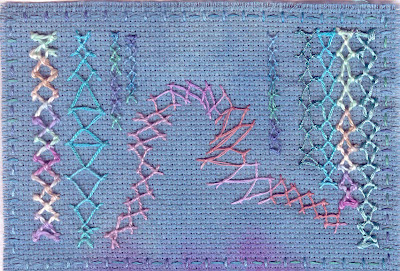I am ecstatic! Coral is one of my signature colors; I wear it well -- in moderation, more about that later -- and I love to use it in my art. It was purely accidental that I came up with the coral of my dreams in a what-the-heck experiment. I must credit my teacher,
Marjie McWilliams, for encouraging us to be daring. She virtually yanked me from my cowering corner double dog dared me to try whatever concoction I fancied.
In other words, clean out those kitchen cupboards and play!
So I find a dust covered bottle of DeKuyper's Wild Strawberry Liqueur. It's been hiding for 15, 20 years -- I remember why I even had it in the first place, but it's well aged now. The color is pretty, so I try it out on a small piece of cotton. After an hour it has an unappealing color, an unpretty amber. What if I added a few drops of red food coloring? Turns out the only liquid coloring I had was green. What I did discover hiding further back in the same cabinet were jars of food coloring pastes from a cake decorating class I took a decade or so ago. I kept adding small amounts of red paste until I thought I had a strong color.

It's not red; the cotton is a pretty peach , but the silk ribbon is nice shade of brick or russety red, rather different than appears in the above picture or below. I liked the ribbon color so much I decided to do a larger batch. I pulled it from its wild strawberry bath after soaking half the time, and then came my Eureka moment and the yummiest coral shade ever!

It is a shame the scanner isn't picking up the vividness of the color. Oh, my feet are still happy dancing. I have to wear coral sparingly, usually as an accent color. Otherwise it is far too attention-getting, and I don't always want to stand out. Let me put it this way. I once wore a coral cape while walking down a San Francisco street. I suddenly heard my name called out; a colleague from Kentucky who had no idea I was even in CA spotted me. I have a lovely silk outfit of this same coral . I only wore it once. People stared, but I think it was because I looked more like the Mango character from Saturday Night Live -- only rotund.
Instead of feeling fabulously flambuoyant, I felt conspicuous. Another occasion, another attitude, I could pull it off; my alter ego could shine as the
Flamingo Floozy.
Not every experiment gets me worked up. Above are a couple of duds. The top is beet juice; most of the color rinsed out, and rest disappeared with the mordant soaks. The dirty yellow comes from doubled strength peppermint tea and the addition of dried mint. I was hoping at least for a greenish yellow, and I'd so hoped for little tiny spreckles of darker color from the mint leaf flakes.




























